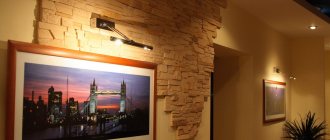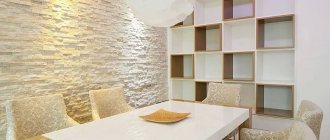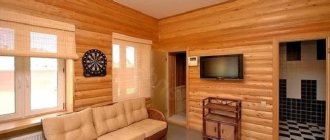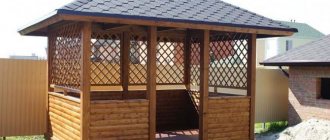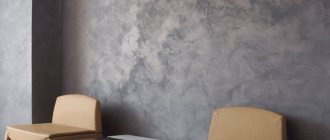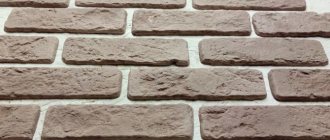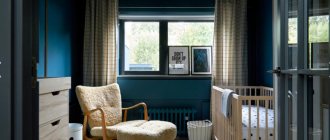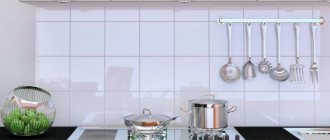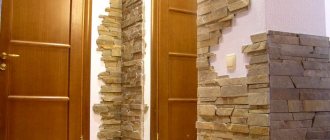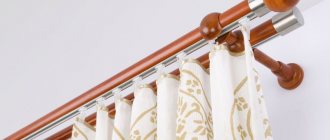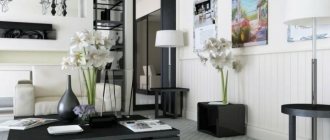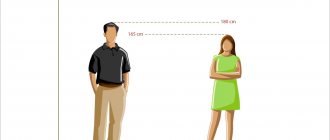Home / Ceiling design / Design solutions / Using gypsum tiles for wall decoration
Decorative coatings based on gypsum have become one of the most popular types of interior design for a wide variety of purposes. For example, interior wall decoration with gypsum tiles is a favorite technique of many designers and this is one of the most popular types of finishing today, not inferior in popularity to decorative plaster or wallpaper.
Plaster finishing in the interior
In any type of interior, be it a living room, office, cafe or retail space, gypsum finishing contributes to the creation of a modern and unique design. Often this material finds its application in the interiors of exhibition halls. Plaster tiles are quite capable of transforming a dining room, office, corridor, or kitchen beyond recognition.
Columns, plasterboard arched structures, and niches are decorated with gypsum material for interior decoration. It is capable of completely reproducing and repeating the relief and texture of the surface (which cannot be said about tiles). At the same time, there are varieties of gypsum elements with a completely smooth front side.
In the living room
In the common room, a design technique such as tiling one wall is used. While other walls are left wallpapered or painted. Individual decorative elements in the living room are also very well perceived visually if they are decorated with plaster decor. However, when decorating a fireplace in the hall with plaster, one should take into account the temperature contraindications of the material. Columns lined with brick or natural stone look extraordinary
But here it is important to correctly find the optimal lighting angle. Front lighting is not suitable for brick finishing
And the light coming from above and slightly from the side is an excellent addition, focusing attention on the delightful decor
In the kitchen
Decorative gypsum tiles are also suitable for decorating kitchen spaces. Here you can use it to decorate, for example, a ventilation duct. In addition, the tabletop of a dining table or bar counter made of gypsum tiles will look simply gorgeous. But it is not recommended to finish the apron in the washing area with plaster due to impracticality and rapid loss of aesthetics.
In the bedroom
In the bedroom, plaster is usually used to decorate the wall opposite the bed or a niche at the head of the bed. Since the bedroom is a place where peace should prevail, the white plaster finish looks very appropriate and beautiful here. Also, a classic interior in white creates an indescribable feeling of cleanliness and freshness.
In the hallway and corridor
A nondescript corridor space can be enlivened by doorways and arched openings with plaster decor edging.
In the bathroom and toilet
In sanitary and hygienic premises, the use of gypsum is not recommended due to increased vaporization and humidity in them. However, some owners do not limit the possibilities of using gypsum, successfully finishing bathrooms and toilets with it. Obviously, they cannot do without coating the decorative material with water-repellent compounds.
General recommendations for choosing colors
When choosing decorative gypsum tiles for any room, you need to take into account the optical properties of different colors. For example, light shades will visually expand and enlarge the space, while dark shades, on the contrary, will reduce it
If you intend to make your interior more energetic, then you need to select finishing materials in red, beige or brown tones. To give the atmosphere of the room the effect of peace and bliss, it is worth finishing it with tiles in light shades (besides white, blue is well suited for these purposes). Overall, gray and white are versatile finishes that will fit well into any design. It is much easier to match other finishing attributes and accessories of a modern interior to this plaster color.
Advantages of 3D panels
Gypsum panels have gained mass popularity not only because of their unusual and attractive appearance, but also because of a number of other advantages :
- Versatility . All kinds of three-dimensional drawings that manufacturers offer will be appropriate in absolutely any room. They will perfectly complement the interior of the living room, bedroom or even kitchen. 3D panels are suitable for all interior styles, giving it unique features. You can paint the panels, varnish them, or cover them with wallpaper. You can perform either seamless installation or specifically highlight each slab. Whatever you choose, it will be unique in any case.
- Practicality. Properly installed high-quality 3D panels can serve you well more than 50 years and not lose your external attractiveness. Gypsum promotes normalization level humidity indoors, so practically no dust settles on it. He has a high warm- And soundproof properties, so using this method of decorating walls, you will not only decorate them, but also insulate them and get rid of extraneous noise from neighbors. Gypsum does not burn, does not conduct electric current, protects from radioactive radiation, does not emit harmful substances and is very simple V care.
- Environmental friendliness . Recently, it has become very fashionable to give preference to natural materials in interior design. It is not only beautiful, but will also have a positive effect on your health. Gypsum is an environmentally friendly, hypoallergenic material that is absolutely safe for health. Therefore, you can safely use the panels even when decorating a children's room . It is very easy to check the panel for compliance with the declared environmental friendliness, without even requiring special certificates. If the panel breaks when dropped, it means that it is indeed made of gypsum without unnecessary additives.
- Price . In addition to gypsum wall panels, there are also panels made from MDF, metal, bamboo, glass, plastic and other materials. Apart from plastic panels, which look quite cheap, gypsum panels are the most affordable. In addition, the pricing policy depends on the complexity of the design, so everyone can choose the option that suits them.
Tile design options in the interior
There are a large number of different designs, for example, 3D tiles with patterns in the form of waves, ripples, circles, honeycombs and other shapes. Such voluminous finishing advantageously complements the entire interior space and gives it originality and originality.
The photo shows a wall in the living room decorated with voluminous white gypsum tiles.
Also, this cladding can be completely smooth slabs, decorated with various ornaments, geometric patterns and lace monograms, or imitate old brick, which is especially attractive for connoisseurs of authentic design.
The photo shows the bedroom interior and 3D gypsum tiles with a wavy pattern on the wall.
An equally interesting effect can be achieved using gypsum tiles in combination with wallpaper, decorative plaster, wood panels or using partial finishing, which can be laid out in a straight line, a ladder or abstractly.
What it is?
Gypsum is calcined gypsum stone that is ground into a powder.
Important
The environmentally friendly natural material lies in a thick layer on the surface of the walls and hides existing visible defects well.
Gypsum plaster contains a large percentage of this material and various additives. They are necessary so that the mass does not harden on the surface too quickly and it would be possible to apply the finishing coat and make a drawing without rushing.
Gypsum decorative plaster, in addition to the main component, contains:
- Fine fillers. They lighten the weight of the building mixture. The most commonly added materials are expanded polystyrene, foam glass and perlite.
- Plasticizers that increase elasticity.
- Whitening particles. Lime or similar materials may be added.
- Retarders.
Thanks to fillers, thermal insulation properties are increased and adhesion is enhanced.
This gypsum plaster can easily be applied to any type of surface . This:
- brickwork;
- concrete walls;
- glossy surface;
- expanded clay concrete;
- aerated concrete;
- cellular foam concrete.
- horizontal or vertical - before finishing It can be used to form walls and ceilings, but in conditions of normal humidity. Recommended to be used for sealing:
- pits;
- cracks;
- cracks.
Suitable for residential/non-residential premises. But only interior finishing needs to be done.
Where to buy beautiful and reliable decorative tiles
The modern construction market for finishing materials provides ample opportunities for the implementation of various design ideas. However, do not forget that the final result depends on three main factors.
How to get the perfect “brick” interior:
Competent and adequate design project. At the same time, it is not at all necessary to hire an expensive designer. It is enough to check your visual expectations with one of the ready-made solutions, which can be easily found on specialized Internet resources. The more architectural and situational coincidences, the greater the confidence in the correctness of the chosen option.
High-quality material that has stood the test of time. The price of the material is not a priority when deciding to purchase tiles. The declared characteristics must correspond to the real ones, and the performance properties must be confirmed by practice.
Professional styling
It is important to understand that laying gypsum tiles is not a highly specialized technological process. Therefore, when talking about professional styling, you need to keep in mind a process that fully complies with a specific technology.
That is, self-installation can also be professional, if all the requirements related to the process are met.
To meet market expectations, the Kamennaya Faktura brand has introduced a number of products that accurately imitate brick and natural stone. These include gypsum interior or concrete exterior tiles, truly inspired by the unique shape and texture of brick and stone.
Each tile model is available in at least two or more color versions, selected specifically for a specific product. Look at examples of textures and colors of brand products.
Vintage loft
Classic white
Compact loft
Vintage monochrome
Original loft
Vintage white
As a result, such a brick imitation simply wins the hearts of people who appreciate truly stylish design. Modern technologies, high-quality materials and many years of experience allow us to obtain shapes, colors and textures that really look like real brick and stone in a variety of styles and shades.
The full range of products can be found on the official website of the company kamen5.ru on its main page.
The brick form has been a classic example of simplicity and timelessness for many years. Thanks to this, an imitation of its texture can become an addition to the dominant style, a background for interior items, additions to them, or the main element of room arrangement.
The color of the product greatly influences the visual perception of the final result. When purchasing brand products, you can be completely sure that the color will be as it should be, and not for one or two years. After all, only original German coloring pigments are used in production.
Stylish living room
More space
Red brick tiles
Classic white
The texture of the brick is based on many years of tradition, so it is completely resistant to momentary fluctuations in fashion and short-term trends. At the same time, traditionalism does not force you to choose the interior of any one specific style. It is important to note that the tiles of the “Kamennaya Faktura” brand are made from reliable modern components, which guarantees their high quality. Brick-like tiles from “Stone Texture”, easy to install
To create the desired effect you will need a minimum of tools. General instructions and attentiveness are enough so that all the work can be done independently, without involving a team of expensive specialists
Brick-like tiles from “Stone Texture”, easy to install. To create the desired effect you will need a minimum of tools. General instructions and attentiveness are enough so that all the work can be done independently, without involving a team of expensive specialists.
Brick accent wall
Shades of Gray
Element on the stairs
Contrast on a white background
In essence, it is a practical choice and an investment in stylish design that will last for many years. This solution makes it possible to obtain an unlimited number of unique arrangements. Moreover, in a pinch, gypsum tiles can be painted a different color quite easily.
How to avoid counterfeiting
If you decide to purchase 3D panels from a manufacturer , then be sure to choose a company that has all the sanitary and epidemiological, as well as fireproof certificates , which can confirm the quality of their product. Always give preference to manufacturers who have their own production site. Never buy products online unless you have had the opportunity to personally touch and inspect the quality of the panels from the chosen manufacturer, for example, from friends. If, nevertheless, you decide to take a risk, then the packaging in which the goods will arrive will tell you a lot. A self-respecting manufacturer always treats his products with care, therefore, the packaging will be appropriate. Ideally, the panels should be packed each in a separate cardboard box and wrapped with a special shockproof film with air bubbles.
The edges of the panels will also tell you a lot . From a high-quality manufacturer, they are perfectly even and perpendicular to each other, which allows you to easily perform seamless installation and not waste effort on grouting uneven joints. The pattern of will match perfectly on each tile and you won’t have to worry about matching.
Surface quality is one of the most important indicators of panels. Manufacturers who strive for market leadership are very sensitive to this parameter. They invent new and improve existing production technologies that would allow them to achieve a perfectly flat surface. You just need to run your hand over the panel and it will immediately become clear to you whether this is a quality product or the brainchild of an unknown production. The surface should not have roughness, unevenness, and especially particles of small debris or abrasive. Having a smooth surface will allow you to save significantly on finishing . If the product you received does not meet these requirements, be sure to return it to the seller, otherwise you will suffer more during installation than you will receive aesthetic pleasure.
Pilasters and columns
Soaring structures of round or rectangular shape with carved surfaces and columns are the hallmark of Hellenic and ancient Roman architecture. They are successfully used in our time.
Columns are structures in the form of a high pillar. They can be used as a support, or installed as a decorative element. Their type is pilasters. They always have a rectangular shape and serve as a full-fledged element of the wall. This form of decoration was also invented by the ancient Greeks, and when developing the design of a modern home, it is used quite often.
These elements are also used in exterior decoration, but they differ in size. The traditional color is white, but if necessary, dark columns can be created by adding paint to the solution.
Application methods
Gypsum decorative plaster can be applied in two ways:
- Manual. Dilute the solution in a container, throw it onto the base with a trowel, starting from the bottom and moving up. The lower layers should be thicker than the subsequent ones. Using the Rule, each section should be leveled in the same direction with an oscillating movement from side to side.
- Using a spatula, they are straightened and all defects are repaired (strokes, chips, protrusions visible after repair).
- Then, using a trapezoidal rule, marks and irregularities are trimmed.
- It is necessary to periodically run a spatula over the previously laid plaster from the bottom up to avoid sagging.
- Machine. The special device consists of a container for the solution, a hose with a gun in the form of a nozzle, a compressor, a power cable and a control panel.
Buying such a complex for one time is unprofitable and expensive. You can rent a car or invite professional finishers. The finished mixture is placed in a container and supplied under pressure through a hose from the control panel. The correct position of the gun when spraying the mixture is 3 cm from the wall. The layers should overlap each other. At the last stage, the surface is rubbed manually.
Unusual coloring
In addition to painting using conventional compositions, there are several non-standard options that will allow you to create with your own hands a magnificent “palace” decoration of the interiors of a house or apartment.
Under old marble
If you like the effect of aging surfaces, you can make the artificial stone look like antique marble. The painting technology is as follows:
The purchased facing material is kept in a darkened room for 48 hours. If the artificial stone is made independently, it is pre-dried. The maximum permissible drying temperature is 55 degrees; Heat up the drying oil
This work requires maximum caution and must be performed with protective gloves; Using a flute brush, the material is coated with drying oil, preferably in 2 layers. It is necessary to ensure that the stone is processed evenly, without gaps; It remains to wait a little time, and soon the gypsum surface turns out to be colored with veins, like ancient marble
It makes an excellent finish for the kitchen or fireplace area.
Under terracotta
The surface is treated to resemble terracotta using rosin and shellac varnish, which are dissolved in industrial alcohol. The principle of painting is the same as when painting marbled. The terracotta effect also appears after some time.
Creating a bronze sheen
To obtain a bronze tint on the surface, materials are prepared and actions are performed in a certain order:
- Drying oil is applied to the surface so as to thoroughly saturate the plaster with it;
- The product is dried. As a rule, this takes 8-10 hours;
- Bronze powder is mixed with varnish, then the product is treated in 2 layers;
- The material is thoroughly dried;
- Prepare a mixture: for 0.3 liters of water – 0.1 liters of acetic acid and 10 g of silver nitrate;
- A thin layer of bronze powder is applied to the surface and covered with a solution. In this case, an oxidation reaction occurs;
- The surface is wiped with a piece of velvet.
Painting using stain
Stain allows you to get very beautiful and unusual surfaces. You can apply it using a spray gun, but the best result is obtained by dipping the product into the solution. Warm up the stain a little, dip the gypsum stone into it for a couple of seconds, and then dry. If necessary, the product is pre-wiped.
Calculation of plaster consumption
The consumption of gypsum plaster per 1 m2 is influenced by several factors:
- curvature of the walls - the greater the slope or height difference, the thicker the layer of plaster is needed;
- type of mixture - grinding depth and consistency affect technological consumption rates. Indicated on the packaging;
- manufacturer - the plasticity of the solution depends on the additives added. But this is a double-edged sword: convenient application equals increased consumption, for which you have to pay.
Master plasterers use several calculation methods to calculate the amount of dry mixture. More accurate results can be obtained after installing the beacons. To do this, design points are marked vertically and horizontally at equal distances from each other on the wall surface. Experts call them key. The more there are, the more accurately the required volume of the mixture is determined.
Then, at each point, the distance from the wall to the conditional plane, which is formed by the beacons, is measured. The resulting numbers are added and divided by the number of measurements. The result is an average layer thickness. Then everything is simpler. The area of the surface to be plastered is found (window and door openings are subtracted from the area of the wall), the consumption rate is taken and the amount of dry plaster in kg is calculated. The formula looks like:
V = S x T x N x k , where:
- V is the volume of dry gypsum mixture, kg;
- S—wall area for plastering, m2;
- T—thickness of the plaster layer, cm;
- N—consumption rate for a layer of plaster 1 cm thick, kg/m2;
- k is the coefficient of unaccounted losses. For professionals it is around 5%; home craftsmen need to target an overrun of around 10-15%.
The procedure ends with determining the number of bags. To do this, the result obtained when calculating using the formula is divided by the weight of the bag and rounded up.
How to paint
To properly decorate man-made stone, you can use acid or acrylic paint. These dyes penetrate deeply into the structure of the stone, dry quickly, and are resistant to fading. Before starting staining, be sure to check that the composition is in working order and has no lumps or clots. If necessary, the paint is diluted with water and diluted with a primer. Here is a brief description of the dyes:
Acrylic. This is a water-based solution that is ideal for painting gypsum stone. It is elastic, resistant to external influences, and does not crack over time.
Silicone and silicate. These dyes are mainly used for outdoor use. The binders in these compositions are silicone resins and liquid glass. The advantage of such a coating, in addition to aesthetics, is a long service life. It is about 20 years old.
Copper and iron sulfate. These solutions are used as impregnation. They help increase color durability. Iron sulfate gives the cladding a yellowish tint, copper sulfate gives it a blue tint.
Stain. For coloring gypsum and cement decorative materials, an acid stain or woodworking compound is used.
Minuses
The list of advantages of this material is very impressive, but it also has certain disadvantages that you need to know about before making the final decision on choosing a finish. The most significant disadvantages of this design will be:
- Poor water resistance and ability of gypsum to absorb water. It can simply get wet if you use such a coating in a damp room without a special protective varnish.
- Difficult to clean slab surfaces. They have a pronounced rough texture and dust and other pollutants accumulate on the surface over time. It is difficult to clean them out of all the roughness.
- High risk of purchasing low-quality products. Many manufacturers skimp on raw materials, resulting in very fragile parts that break in the hands during installation.
Despite these disadvantages, decorating walls with gypsum elements has become a very popular way to transform standard interiors. This means that despite the existing disadvantages, the number of advantages was able to outweigh these disadvantages.
Creating a style
For gypsum stone there are no restrictions on the premises where it can be used. Much depends on a sense of appropriateness and moderation.
Bedroom
The bedroom is designed to gain strength and relax
Therefore, it is necessary to pay special attention to comfort. To do this, it is important to avoid flashy tones and colors, as well as an abundance of different styles.
Therefore, gypsum brick must be used with caution in this room. Brick can be placed at the head of the bed to emphasize the seating area. Another advantage of this placement is that during rest a person is not forced to constantly observe the plaster finish
If you want to lay brick on the walls, you need to select light colors for it, which will help you get in the mood for a working day and in a positive mood
Therefore, gypsum bricks must be used with caution in this room. Brick can be placed at the head of the bed to highlight the seating area
Another advantage of this placement is that during rest a person is not forced to constantly observe the plaster finish. If you want to lay brick on the walls, you need to select light colors for it, which will help you tune in to a working day and in a positive mood.
You should not use gypsum bricks to decorate a bedroom if you plan to install a large amount of dark-colored furniture in it. This combination will create clutter and tension, which is not good for the bedroom. Brick can be used if the room has a light-colored wardrobe or a dressing room. After finishing, the walls should not be filled with various objects or covered with a large number of paintings. One or two will be enough depending on the finishing area.
Kitchen
The use of gypsum bricks in the kitchen also has its limitations and nuances. It would be good if a detail was made on the apron or the wall opposite the kitchen unit. In the first case, the shade of the gypsum brick is matched to match the countertop, and in the second, to match the kitchen unit or the predominant shade. Plaster brick goes well with furniture that has large glass inserts or chrome elements. Light stone can be used if you want to decorate your kitchen in a Scandinavian style. In this case, the entire wall with the kitchen unit can be covered with brick.
Advice! Furniture that has glossy facades does not fit well with gypsum brick, which is important to consider when finishing.
Hallway
A fairly practical solution is to decorate the entire surface of the walls in the hallway with brick. But in small spaces it can create the feeling of a tunnel or well.
That is why in hallways it is important to choose the right areas where brick finishing will be carried out. It was said above that these could be doorways or external corners
In spacious hallways, the amount of gypsum brick can be increased, but it is better to use light paint colors.
Living room
This is one of the rooms in which residents and guests spend the most time. Therefore, the overall atmosphere should be pleasant and light. To achieve this, just follow a few simple rules. One of them is laying bricks on parallel or adjacent walls. This approach is relevant for large living rooms; often it is enough to finish only one wall. If there is a fireplace in the living room, then the wall next to which it is located can be lined with bricks and the fireplace itself can also be lined with gypsum bricks
It is important to be careful about how many types of finishing materials will be used in the living room
In studio apartments, where the living room is one room with the kitchen, decorative gypsum stone can be used for zoning along the line of transition from one room to another. Framed family photos look good on the area where the finishing is done with gypsum stone. Often, living rooms are made to imitate old brick. To achieve this, the front surface must be corrugated; it is also coated with a special red composition. A special effect can be achieved by using contrasting filler for joints. A video about the process of laying decorative material is below.
Advice! Before laying decorative stone, high-quality surface preparation must be carried out. It must be sufficiently smooth and impregnated with a primer so that moisture from the gypsum composition does not leave too quickly, which will lead to cracks and poor adhesion of the adhesive composition.
Production technology
The process is actually nothing supernatural . The gypsum solution is mixed using special equipment. It is recommended to use G-16 gypsum , which is very plastic and non-flammable. To give the finished product strength and resistance to impact, some manufacturers add special plasticizers or fiber fibers to the gypsum mixture, thereby worsening the environmental friendliness of this type of decor. The finished mixture is poured into special plastic molds that repeat the required pattern.
The molds for the panels are made very carefully, first creating a 3D model using a special computer program. Artists and designers with extensive experience work on creating forms. Then the computer model of the form is cut out on a special machine and modified until it fully matches the artist’s idea. Only after this the finished matrix can be used in mass production.
While pouring the mixture the matrix vibrates a little ; this is used to ensure that the material is evenly distributed throughout the mold and does not form internal voids. Next comes the drying process. The forms are allowed to sit for 20-30 minutes, after which the panels are removed and sent for further drying in rooms with controlled temperature and humidity. After complete drying, the product is considered ready. Naturally, the entire process is fully automated, all proportions are strictly observed, and the quality of the surface and edges of factory panels is always at the highest level.
Of course, the use of modern equipment and labor costs slightly increase the cost of the finished product. If you are not limited in funds and can afford to spend a decent amount of money on this type of finishing material, then, of course, it is better to buy 3D panels from trusted manufacturers. But if you are used to doing everything with your own hands and want to make sure that this is a truly environmentally friendly product without unnecessary impurities, we suggest trying to make the panels yourself .
Reliable base for gypsum metal elements
This material is popular among experienced interior designers. Drywall is glued to a regular metal sheet on one or both sides. For decoration you can use stainless steel, aluminum, galvanized sheet. In some cases, the steel may not have a protective coating.
But all other materials must be covered with a film of polymers. Such slabs are not often used in private apartments and houses, since there is a certain limitation in the color palette. Such sheets are relevant for cladding structures for industrial purposes, the food and pharmaceutical industries.
Finishing in a public organization
The peculiarity of this material is that the specific coating guarantees sterility, and it is not afraid of solutions of alkalis and acids. They are implemented in combination with a special profile from which the frame is assembled, strong frames are built around the openings, and all joints are covered. It is customary to install extensions on baseboards and convex corners.
The installation principle differs in that all sheets are alternately attached to the racks of the side metal projections. Lock fixation is carried out least often. In the resulting gap, professionals place a durable profile, the color of which matches the shade. This approach allows you to make all joints invisible.
Current application
Tips for choosing
Before purchasing panels, you must know the quantity required , because buying more is not a problem, but it will be a shame to overpay for the extra. It’s easy to make a calculation if you know the dimensions of one panel, even at the place of purchase. The choice of shape depends only on your personal preferences. Remember that it is better to choose quality manufacturers and make a purchase directly in the store, having previously assessed the quality of workmanship, and not on the Internet. Don't be tempted by the low price. If the price of the panel differs significantly from the average pricing policy, this means that manufacturers use low-quality materials and do not have quality certificates, which you must ask the seller before purchasing.
Place the two panels next to each other, if
the pattern matches perfectly and the gaps at the junction are insignificant , then you have a quality product. Try to touch the front surface of the selected panel - it should be perfectly smooth and even. If the product you have chosen meets all these requirements, feel free to make a purchase and hurry to make your interior magical!
The article was written for the site.
Tags: Apartment design, Wall panels
Types of gypsum tiles for interior decoration
There are several varieties of this finishing material.
Under the brick
Cladding with imitation brick has a small thickness and is perfect for decorating both small and more spacious rooms. This finish saves space and is an excellent option for decorating walls or framing openings.
The photo shows the interior of the kitchen-living room, decorated with gypsum tiles with imitation brick.
Under the stone
These products can have different shades and are visually no different from natural stone. Gypsum tiles that imitate slate are often used for cladding living rooms.
Under the tree
Finishing with a textured imitation of expressive and layered tree bark accurately conveys the natural wood print and embossing.
Geometric and abstract shapes
With the help of such facing material, it is possible to give the interior unusualness, exclusivity, elegance and create a classic and slightly strict or spectacular and luxurious design.
Variety of shapes
The most popular manufacturers offer 3D panels with truly unimaginable patterns . But they can be combined into several main groups .
- Lines and waves . This is the simplest and most common form of 3D panels. They have very soft smooth shapes , and the width and intensity of the lines are quite varied. They can have a horizontal, vertical or diagonal direction and imitate the slight bends that sea waves or large stripes of varying widths leave on the sand. They can also have different protrusion heights above the main surface of the panel and be barely noticeable or characteristically pronounced. This motif is very suitable for a recreation area . This calm, unobtrusive ornament sets the mood for relaxation and gives a feeling of comfort.
- Honeycombs . This version of the 3D panel looks very interesting in the hallway or hall . Honeycombs can have both large and small cells. The panels can be smooth and only follow the contours of a honeycomb, or they can be voluminous and protrude or sink in relation to each other to different depths. The latter option looks more impressive and realistic . The honeycombs can have either the usual hexagonal shape or be slightly elongated. This effect adds more volume to the surface on which it is used.
- Stone . the much-loved brickwork using 3D panels. Bricks can have a smooth or textured surface, which makes them even more similar to the real material. They can repeat the laying in a checkerboard pattern with the same seam, or they can be located on the panel perpendicular to each other with a large distance, or simply repeat horizontal lines. Also, 3D panels can imitate cracked plaster , rough surface of granite , spongy shell and other types of natural stone, both in shape and texture. Such panels look very discreet and natural . Suitable for decorating a fireplace area in the living room and for the hallway.
- Imitation of fabric and other materials. This is a very interesting type of panels that can very well imitate upholstery fabric, and even have buttons, like on leather sofas. They can imitate the structure of wood fiber , genuine leather or luxurious tapestries . This design looks very chic and expensive, especially in spacious offices or libraries, and a skillfully selected color will help achieve maximum naturalness.
- Abstraction . Abstract panels will fit well into an interior in a loft, hi-tech or minimalist style. used are very diverse . These are rhombuses, small labyrinths, and rectangles of different sizes, located at angles to each other and protruding above neighboring elements. These can be braids, the effect of crumpled paper, large or small circles, lines resembling a snake, all kinds of bends and fractures, triangles, puzzles and other geometric shapes. Such an ornament is not obligatory to anything, but at the same time, it is very original and “ alive ”. There is an immediate desire to touch such a surface. Such 3D panels will look great, perhaps, in any room .
- Bubbles and spheres . Imagine a soap bubble show! And on your wall? There are panels that really look like big bubbles of different sizes. It looks very unusual and immediately resembles a spaceship. There are panels that resemble raindrops on glass, or circles on water, or just small ovals, arranged in random order and intersecting with each other in different places. Such panels would be appropriate in the bathroom , especially since there are moisture-resistant 3D panels.
- Floral ornament . The variety of shapes of this type of panel is probably the richest. These are all kinds of flowers of large and small sizes , plant trunks intricately intertwined with each other, leaves of various plants, bamboo, huge asters, orchids, ivy, daisies and roses, or just individual petals. These panels look very rich, so we would recommend using this type to decorate a wall panel , otherwise it may be too cluttered. Although, this is also a matter of taste.
As you can see, choosing a 3D gypsum panel will be very difficult, so imagine in advance what this or that form of panel will look like in your interior. Focus on the furniture and decoration of adjacent walls. If your interior is dominated by calm, strict colors and shapes, then you should choose similar panels. This tandem will successfully emphasize the depth and elegance of your room and will look appropriate.
Advantages and disadvantages
Gypsum tiles have their own characteristics, which provide them with well-deserved popularity.
The advantages of the material are:
- light weight - thanks to this it is excellent for finishing thin walls and plasterboard partitions;
- the ability to veneer any base;
- frost resistance - withstands at least 50 cycles with honor;
- heat resistance – not afraid of heating up to 70 °C;
- environmental friendliness and absence of toxins in the composition;
- ease of cutting and installation;
- accessibility for any budget;
- the ability to make tiles yourself.
The disadvantages include:
- relative fragility;
- insufficient moisture resistance.
Where to use
Given the poor water resistance, it is not recommended to use this type of coating in bathrooms or on balconies, where humidity will always be high. The kitchen can be an exception if the surface of the slabs is coated with a protective varnish. However, in other parts of the house this material looks great and can last for many years. For example, decorating a wall in a hall or living room with relief details made of plaster is a very commonly used decorative option.
It is also often used for partial surface decoration. You can line door or window openings with such tiles, lay out an intricate pattern on a separate section of any wall, or completely cover a large surface with such details. There are a lot of options for using such coatings, and the photos below show several examples of what wall decoration with different types of gypsum tiles can look like.
Tip two: practical plinth
The baseboard is a narrow strip of material that covers the junction of the wall and the floor. This is an integral part of the classic style interior, but is also quite popular in more modern design options. The material for this decorative element can be wood or any artificial material, but gypsum against their background has one very significant advantage - it can be easily corrected if chips or distortions occur.
If desired, it is very easy to paint it, making it the same tone as the walls or matching the tone to the color of the floor. Due to the non-flammability of gypsum, it is a safe frame for sockets.
Choosing brick tile color
The selection of cladding depends on the purpose of the room. The tile can be a bright spot around which the composition is built. For example, for a room in olive tones, you can buy finishing material in a sand or bright terracotta shade. Beige tones will look harmonious, they will softly fit into the interior.
Olive, emerald-colored furniture and curtains will look good against the background of red-brown “brick” walls
They will become an element that attracts attention. Masters create a composition from elements of different shades
The design may contain parts painted in contrasting colors. The surface cladding is often made from bricks that are similar in tone.
Craftsmen create a composition from elements of different shades. The design may contain parts painted in contrasting colors. The surface cladding is often made from bricks that are similar in tone.
Kinds
The variety of gypsum cladding is determined not only by its shape, color and dimensions, but also by its texture features.
The most common tile variations are:
- imitation brick - its insignificant thickness allows it to fit perfectly into small spaces, decorate openings and individual areas of the hall or kitchen - bar, television. This type of decoration looks no less impressive in spacious rooms;
- imitation of natural stone - products are available in various shades and are practically indistinguishable from natural material. Particularly popular are aerated concrete tiles, which convey the texture of slate. Special coloring solutions help achieve shine. No less in demand are gypsum cement samples, which are used to decorate arches, fireplaces and niches.
Each of the presented options has its own advantages and is endowed with unique properties. The choice in favor of a certain type of tile is made depending on the style of the interior, the dimensions of the room and the personal taste of its owner.
How long will it take to dry?
To continue finishing work, you need to know not only how long it takes for gypsum plaster to dry, but also at what speed it gains strength. After all, the finishing touches: gluing and painting can begin after the plaster has completely hardened. This takes from 3 to 7 days, depending on the thickness of the layer. But it’s better not to risk it and start the next stage of repairs in a week. But the applied solution dries within 1-2 days.
The process of strengthening should take place under natural conditions at a temperature of +5-+25°C. No heat guns, heating devices operating nearby, or drafts.
Checking the moisture content of the plaster.
Before subsequent finishing, the room is ventilated and the plaster is primed. The surface ready for wallpaper or paint should be smooth and light. Humidity for wallpaper should not exceed 4-5%, for paint - 1%. Drying up to 10 days may be required to achieve this moisture content.
Do-it-yourself installation of gypsum stone
One of the advantages of gypsum stone: you can install it yourself. To attach the tiles, you need to use cement-based adhesive, gypsum plaster and silicone sealant.
Gypsum decorative stone in the living room
It is better to glue the tiles onto plaster. This white mixture is not noticeable under decorative brick. Cement adhesive is suitable for all types of stone and tiles. Sealant is used less frequently in installation, although it also provides good adhesion.
Gypsum decorative stone in Art Nouveau style
Before installing the tiles, the surface must be prepared: remove wallpaper and remaining paint, fill cracks, remove uneven surfaces. To make the masonry even, you need to use a suspension - a thread with a bearing or other weight.
Gypsum decorative stone in a niche
Artificial stone is actively used in decoration today. They decorate niches, fireplaces, arches or entire walls. This material can be combined with different finishes and all kinds of furniture, so it is used in different design projects. Gypsum stone is inexpensive and easy to install, which is why buyers prefer it.
Gypsum stone in arch decor
Materials and tools
To work with gypsum dry plasters you need to have:
- dry mixture;
- primer;
- reinforcing mesh made of fiberglass, basalt or plastic;
- metal profile for beacons;
- self-tapping screws;
- special clamps for attaching beacons: “Kremmer”, “Ushastik” or clips. What they are and how to use them can be found here.
Tools and equipment needed:
- stepladder or strong table;
- container for mixing the solution - a 10 or 12 liter bucket;
- electric drill or powerful screwdriver with different attachments (mixer, drill and cross-shaped bit);
- grinder or metal scissors;
- trowel (trowel) for applying mortar to the wall;
- h-shaped rule - for leveling and redistributing the solution;
H-shape rule.
- trapezoidal rule for pruning;
- spatula, even better two: wide and narrow. The first is used for polishing the solution and instead of the falcon, the solution is collected, the second is for processing hard-to-reach places;
- primer cuvette;
- roller or mat - walls are primed;
- sponge grater for polishing the surface. You can take P400 sandpaper and wrap the block;
- laser level or building level;
- roulette;
- plumb line;
- fishing line or twine for hanging walls;
- simple pencil.
Self-production
When producing gypsum tiles at home, it is worth considering the weight, dimensions of each fragment, its geometric shape, the number of tiles and the features of the room. The manufacturing process is simple: you will need molds, plaster, a construction mixer, slaked lime. If colored tiles are planned, color is added to the mixture.
If you want to do a special painting, you can do this at the very end of the process, which includes 3 stages:
- pouring the solution;
- drying;
- painting.
Take 6 parts of gypsum, 1 part of lime, fill with water (1: 7 in relation to lime). The consistency of the composition should resemble sour cream; you can stir it using a construction mixer. The mixture is stirred until a homogeneous structure is obtained and poured into molds. Before this, the molds are moistened with water diluted with laundry soap to make it easier to remove the stone in the future.
It is important to ensure that the molds are placed on a level surface.
When pouring, check that there are no air bubbles in the composition. If there is no vibrating table, the molds are shaken several times: this removes bubbles from the poured material. Setting occurs within 24 hours: the forms are not touched, leaving them in a dry room. After a day they are taken out
This must be done carefully: such tiles are quite fragile
If necessary, it is painted using water-soluble paint pigments. To speed up the work, you can use a spray bottle, painting evenly, avoiding different colors. Sometimes finishing putty is used instead of lime.
The shape should be shallow. For brick, a thickness of 0.5–1 cm is sufficient; for slate, a thickness of no more than 1–2.5 cm is sufficient. After painting, the surface can be treated with acrylic varnish. For even coloring, it is worth applying acrylic twice.
Characteristics and composition
The name "gypsum plaster" is not entirely accurate. Gypsum is a mineral from the sulfate class. It has a double structure: fibrous - selenite, granular - alabaster. It is from alabaster that the plaster mortar is obtained, which everyone knows as gypsum.
The technological process is not very complicated:
- the mineral is fired at high temperatures for a long time;
- crushed to a powder state - the smaller the particle fraction, the higher the plasticity and better binding properties;
- additives are introduced:
- fillers with granules no more than 1.5 mm - reduce the weight of the solution. For these purposes, the smallest particles of polystyrene foam, foam glass, vermiculite, and perlite are used;
- plasticizers and modifiers - reduce the speed of setting of alabaster (without additives, after 5 minutes the mixture becomes stone) and improve the level of adhesion.
- bleaches - lime (used before), titanium or zinc based white;
- polymer additives - increase the viscosity and strength of dried plaster.
Available for sale in bags of 5, 15, 25 and 30 kg.
Crushed alabaster.
This is the composition of the dry mixture. Water and retarding agents are added to the ready-to-use paste, as a result of which the solution does not harden without access to air. Pasta is sold in plastic buckets.
Technical characteristics depend on the density of the material and the size of the component fractions. Therefore, specific numbers may vary. The main indicators are:
- color - can be white, gray with different shades, pink and beige;
- The proportion of water for mixing is on average 2:1, where 2 is gypsum, 1 is water. But different manufacturers have deviations - from 0.4 l per 1 kg of mixture to 0.6 l / kg. You need to look at the recommendations on the packaging;
- the thickness of the base layer without reinforcement is from 2 to 5 cm (different for each manufacturer);
- compressive strength - 25-40 kg/cm2 (according to GOST 31377-2008 - 2.45 MPa);
- work is allowed at a temperature of - +5-+30oC;
- solution lifetime - 1 hour (according to GOST - 45 minutes for manual laying, 90 - machine);
- complete drying time - 3-7 days (depending on the thickness of the layer);
- composition consumption per 1 mm of layer - 0.8-1.2 kg/m2 (hand laying - 0.85-1.0 kg/m2, machine - 0.75-0.9 kg/m2;
- adhesion force to the base - 0.3 MPa;
- moisture retention without dripping - 90%. Solutions with 95% appeared on sale, which is much better;
- density - 950 kg/m3;
- vapor permeability - 0.11-0.14 mg/ (m*h*Pa);
- shrinkage of the base layer is not allowed.
Installation of gypsum tiles
Covering the base with decorative material occurs in several stages. Each of them must be carried out completely and according to the rules.
Working with different bases
The surface ready for laying gypsum tiles must have the following parameters:
- excellent strength;
- absence of defects and irregularities.
Please note that installation can be done on different substrates. Therefore, approaches to preparation may differ.
Preparing the surface for laying tiles
Concrete walls do not pose any significant difficulties. The main thing is to reduce possible porosity. To do this, it is necessary to use primer mixtures that have a penetrating effect. If the surface has been painted, then, if possible, remove such a layer completely. If this cannot be done, then the areas with paint are covered with many scratches and plastered. Laying gypsum tiles on brick walls is done using tile adhesive
It is important to ensure that the surface is even and durable. If there is destruction of old areas, then it is necessary to carry out plastering work. Installation on bases made of plywood or gypsum boards is carried out using special adhesives
The main thing is that the wall must be strong, without deformation, and pre-coated with a primer.
Before laying tiles on drywall, its surface must be carefully primed
General installation instructions
The prepared surface must meet the following requirements:
- Be completely dry.
- No significant irregularities. A small difference is allowed.
- The previous coating has been completely removed.
- The cracks are covered with putty.
- The primer composition is applied in two layers.
Next, comes the turn of applying markings, which will allow the process of laying decorative gypsum tiles to be carried out quickly and without errors. Using a level and a ruler, equal points are marked through which horizontal lines are drawn. Their size depends on the size of the selected material.
Marking the wall for laying gypsum tiles
Cladding work is carried out according to the following principle:
- The necessary tools are prepared: a simple and serrated spatula, a rag, a spatula for applying grout.
- The glue is mixed according to the manufacturer's instructions; each has its own characteristics.
- The first element will serve as the basis for the remaining fragments. Therefore, it is better to start work from the selected corner.
- It is necessary to take into account the peculiarity of installation; it is done from top to bottom.
- The prepared composition is collected in the required quantity and applied to the selected area. Using a notched trowel, a uniform surface is formed, the thickness of which should be no more than 5 mm.
- Gypsum tiles to look like stone or brick are pressed and pressed down slightly. It is immediately leveled using a level.
- When trimming is necessary, it is done with a metal saw.
Installation of gypsum products on the wall
It is much easier to veneer without forming seams. Although, it doesn't turn out so beautifully. When it is planned to make a joint, the space is filled with a gypsum-based composition. After waiting about half an hour, it needs to be thoroughly rubbed down.
Wall plates
Any base is suitable for laying decorative tiles. Combine a series of panels or tiles into a continuous pattern. The seamless pattern can be positioned vertically or horizontally, this is reflected in the instructions. When installation is complete, the gap between the panels will not be noticeable. What to consider when installing wall slabs:
- If necessary, use the tile as a separate insert or decoration. Fill a certain space with it, not necessarily the entire wall. The size of the installation is limited only by your imagination and the room's capabilities.
- Painting the surface maximizes the tile's capabilities, as its fine-grained structure absorbs and transmits color well.
- Carefully unpack each panel for installation, allow it to acclimate to ambient temperature and humidity, and prepare it for painting to achieve the desired effect.
- Or order pre-painted wall panels. Factories and companies will professionally paint the product in any color, including beautiful metallic shades of water-based paints. However, pre-painting is not suitable in cases where a seamless installation is required. Choose this method only when it is essential to save time and effort. Painted panels perfectly reflect mood and atmosphere and are especially suitable for high traffic areas.
Wall plate option
With the right texture and color, the stimulating effect increases if you need to get some action from those present:
- decide to purchase or cooperate in commercial establishments;
- eat a lot or little in the kitchen (for a good appetite, choose red paint, and for those who are losing weight, blue is suitable);
- increase creativity and productivity.
At home, you can make rooms more energetic and lively, less busy, or casual and relaxed.
White color makes the room more spacious
Color is important to any design scheme. Bright colors like red and yellow add energy, while blue, green and other cooler colors create a calming effect . The versatility of grey, white, black and brown provides the flexibility to create effects when complementing other colours.
Materials
Gypsum boards are composed of medium-density fiberboard (made from recycled wood) and porcelain gypsum. Sulphate mineral (gypsum) is often used for plaster and wall coverings. The grade of gypsum used in panels and slabs for home interiors is usually alabaster, a fine-grained white/lightly tinted gypsum material. It is a flexible material used for sculptures and can be processed into any type of paint or texture.
Options for using gypsum tiles
Rubble stone
Its structure is similar to that of the wild one. Rubble is the name given to flat pieces of rock, the largest side of which is no more than 50 cm. Decorative material comes in all shades of brown and gray.
Rubble stone is suitable for decorating walls in country houses. It fits perfectly in the interior with natural wood.
This material does not look as bright as torn stone, so it acts as an ideal background for other finishing materials and pieces of furniture. They can decorate part of the wall in the bedroom, in the hallway, in the toilet, in the bathroom or in the kitchen. Here you can decorate part of the wall with similar material and make a kitchen apron out of it.
Gypsum decorative stone in the interior of a country house
Features of the use of artificial stone
Thanks to the variety of patterns and colors, decorative stone is a real “must have” for a modern interior.
Minimalism, if you use stone, becomes less bland, a Scandinavian interior becomes more diverse, eco-style and country style become more convincing, and a loft becomes much more comfortable.
Many ethnic styles are difficult to imagine without facing stone. For example, in a Mediterranean house this is a stylization of pebbles or boulders polished by the sea. In Alpine - under mountain debris. The interior is Provence-like, like sun-bleached sandstone. In English - under a strict cherry-colored brick. Artificial, glossy stone has made its way even into high-tech interiors, this “fiefdom” of metal and glass.
Stone is, of course, a unique tool for creating an extraordinary environment, but you shouldn’t go to all lengths. If you decorate the walls with stone tiles from top to bottom, you will get a crypt, a wine cellar, a dungeon... But not a living space.
Cladding with decorative stone solves several problems. Firstly, it is picturesque, elegant and prestigious. Secondly, with the help of stone you can delimit a room into functional zones, make it more voluminous and expressive.
Options for decorative wall decoration
Bare brick walls give the room a gloomy and uninhabited look. However, today many people choose this design because it is laconic, non-standard and makes it easy to select accessories.
Stylish bedroom design with brick walls
To create the effect of bare walls you can use:
- wallpaper with a brick pattern;
- special panels;
- imitation of brickwork on wet plaster;
- brick tiles;
Let's consider the advantages and disadvantages of each finishing material separately.
Wallpaper with imitation brickwork
The most inexpensive and easiest material to install is wallpaper. Using them to create the effect of bare brick walls will require a minimum amount of time. This wallpaper is perfect for any style of room.
If we talk about the advantages of this material, they are obvious:
- gluing them does not require special experience in construction work;
- During finishing, a minimum amount of debris and dirt remains;
- calculation of the required amount of material can be done directly in the store;
Wallpaper with imitation brickwork
- the period of finishing work is extremely short;
- there is no need to use special tools;
- A large selection allows you to choose the best option at an affordable price.
There are a large number of photos of brick wallpaper in combination with other materials on the Internet.
Decorative panels for walls
Brick panels for interior wall decoration are wear-resistant and highly resistant to moisture. They are actively used for external and internal finishing works.
Brick panels are often used to decorate balconies
Among the advantages are:
- durability;
- light weight;
- long-lasting excellent appearance;
- high sound insulation characteristics.
To make the panels, plastic is used, which is easily attached to the wall using screws or self-tapping screws. Due to the fact that each panel is mounted separately, in case of damage, you can easily replace a separate fragment.
Brick-like tiles for interior decoration
Brick tiles began to be used indoors relatively recently. Before that, it was a material for exterior finishing work. At first, the cost of tiles was quite high, and they did not have a wide variety of design options. Gradually, the color range was expanded and various texture solutions were proposed.
Brick-like facing tiles in the kitchen
Among the advantages of brick tiles it is worth highlighting:
- environmental cleanliness;
- ability to use with various materials (wood, plywood, metal, concrete, etc.);
- durability;
- good sound insulation;
- high resistance to moisture.
Despite the large number of advantages, we should not forget about a number of significant disadvantages. Among them is the need to involve specialists in the work and the mandatory use of special materials. Not the least negative aspect of laying tiles is dirt, the need for preparatory work and a large amount of construction waste.
However, the design solutions obtained through its use will delight the owners for a long time and add individuality to the room.
Decorative stone in various stylistic directions
Natural materials, wood, stone, are organically integrated into a diverse style. Decorative artificial tiles make it possible to choose an imitation of natural materials at an affordable price. For example, natural polished marble is much more expensive than porcelain tiles.
Classicism
This category includes styles: baroque, antique, renaissance, neoclassicism and some others. All styles are united by the desire to recreate a richly decorated, solemn interior with a touch of pathos. Marble, polished granite, aventurine with mica inclusions are decorative companions for such interiors. The stone is mainly used to decorate fireplaces, columns, and wall panels. The main thing is to maintain balanced proportions between all the design elements of the room. Use the slab as a floor covering. Decorative marble-effect tiles are used in bathrooms.
Installation recommendations
Lay decorative tiles using liquid nails or tile adhesive. Overlapping installation can mask uneven walls. The choice of adhesive compositions is quite wide. This choice depends on whether the glue will be noticeable and will differ in color. For light-colored tiles, Unifix adhesive is suitable.
This is an economical and inexpensive composition (for just 345 rubles you can buy a package that is enough to prepare 5-8 liters of glue). The glue must be diluted in the required amount, which will be used in less than an hour. If the tiles will be painted throughout the entire array, you need to choose a more viscous adhesive.
Beautiful examples
Using the Chateau decor you can decorate a wall to look like brickwork. This will add coziness and chic to a country house. The flooring also interestingly combines two shades of beige and brown pattern, laid out diagonally.
The combination of natural wood and small floral patterns makes the bathroom simple and at the same time romantic.
The effect of freshness, sea breeze and airiness is created using the mint shade of the tiles and the floral theme of the decor. The turquoise furniture finish completes the picture.
For extraordinary and bright personalities, a combination of bright pistachio and purple in the bathroom interior can be a relevant and unexpected solution. The white insert calms and balances the overall picture.
For tips on laying tiles in the bathroom, see the following video.
